Agricultural Film Market
Agricultural Film Market Size and Share Forecast Outlook 2025 to 2035
Agricultural film market is projected to grow from USD 9.1 billion in 2025 to USD 12.8 billion by 2035, at a CAGR of 3.5%. Mulch films will dominate with a 46.0% market share, while ldpe/lldpe blends will lead the material segment with a 63.0% share.
Agricultural Film Market Forecast and Outlook 2025 to 2035
The agricultural film market stands at the threshold of a decade-long expansion trajectory that promises to reshape crop protection technology and farming optimization solutions. The market's journey from USD 9.1 billion in 2025 to USD 12.8 billion by 2035 represents substantial growth, the market will rise at a CAGR of 3.5% which demonstrating the accelerating adoption of advanced agricultural technology and crop management optimization across farming facilities, greenhouse operations, and agricultural production sectors.
The first half of the decade (2025-2030) will witness the market climbing from USD 9.1 billion to approximately USD 10.8 billion, adding USD 1.7 billion in value, which constitutes 46% of the total forecast growth period. This phase will be characterized by the rapid adoption of mulch film systems, driven by increasing crop yield requirements and the growing need for advanced soil management solutions worldwide. Enhanced crop protection capabilities and automated installation systems will become standard expectations rather than premium options.
The latter half (2030-2035) will witness continued growth from USD 10.8 billion to USD 12.8 billion, representing an addition of USD 2.0 billion or 54% of the decade's expansion. This period will be defined by mass market penetration of biodegradable film technologies, integration with comprehensive precision agriculture platforms, and seamless compatibility with existing farming infrastructure. The market trajectory signals fundamental shifts in how agricultural operations approach crop protection and resource management, with participants positioned to benefit from growing demand across multiple film types and crop segments.
Quick Stats for Agricultural Film Market
- Agricultural Film Market Value (2025): USD 9.1 billion
- Agricultural Film Market Forecast Value (2035): USD 12.8 billion
- Agricultural Film Market Forecast CAGR: 3.5%
- Leading Product Type in Agricultural Film Market: Mulch films
- Key Growth Regions in Agricultural Film Market: Asia Pacific, North America, and Europe
- Top Players in Agricultural Film Market: Berry Global, BASF, RPC/Berry, Novamont, Shell Polymers
- Where revenue comes from - Now Vs Next (Industry-level view)
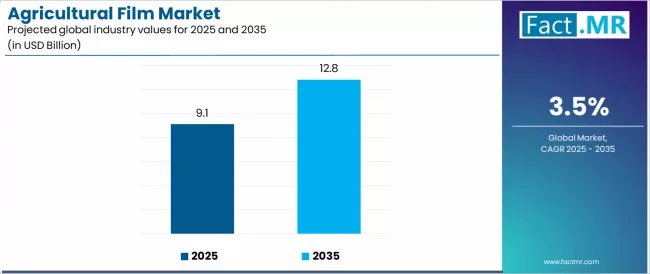
| Period | Primary Revenue Buckets | Share | Notes |
|---|---|---|---|
| Today | Mulch films | 46% | Crop protection-driven, soil management |
| Greenhouse films | 32% | Controlled environment, protected cultivation | |
| Silage & bale films | 22% | Feed preservation, livestock applications | |
| Future (3-5 yrs) | Advanced mulch systems | 48-52% | Biodegradable options, precision application |
| Smart greenhouse films | 30-34% | Climate control, energy efficiency | |
| Specialized preservation films | 16-20% | Extended storage, quality enhancement | |
| Biodegradable alternatives | 2-4% | Environmental compliance, eco-friendly farming |
Agricultural Film Market Key Takeaways
At-a-Glance Metrics
| Metric | Value |
|---|---|
| Market Value (2025) → | USD 9.1 billion |
| Market Forecast (2035) ↑ | USD 12.8 billion |
| Growth Rate ★ | 3.5% CAGR |
| Leading Product → | Mulch films |
| Primary End Use → | Fruits & vegetables |
The market demonstrates strong fundamentals with mulch films capturing a dominant share through advanced crop protection capabilities and soil optimization. Fruits & vegetables end use drives primary demand, supported by increasing food security requirements and crop yield optimization. Geographic expansion remains concentrated in developed markets with established agricultural infrastructure, while emerging economies show accelerating adoption rates driven by modernization initiatives and rising food production standards.
Imperatives for Stakeholders in Agricultural Film Market
Design for crop optimization, not just protection coverage
- Offer agricultural packages: film systems + installation support + crop guidance + trained installers + performance monitoring.
- Preconfigured workflows: installation protocols, crop management procedures, yield tracking, and digital monitoring on farming projects.
Technology readiness for sustainable agriculture
- Real-time crop monitoring analytics, biodegradable alternatives, and precision agriculture integration (soil sensors, climate control systems).
Performance-by-design approach
- Automated installation systems, real-time crop mechanisms, statistical yield monitoring integration, and paperless farm documentation.
Value-based farming models
- Clear base film price + transparent service tiers (installation support, crop consulting, performance guarantees); subscriptions for precision agriculture services and eco-friendly programs.
Segmental Analysis
Primary Classification: The market segments by type into mulch films, greenhouse films, and silage & bale films, representing the evolution from basic crop covering to specialized agricultural solutions for comprehensive farming and crop management optimization.
Secondary Classification: Material segmentation divides the market into LDPE/LLDPE blends (63%), EVA/EBA (21%), and biodegradable polymers (16%) sectors, reflecting distinct requirements for durability, processing characteristics, and environmental compatibility.
End Use Classification: Crop application segmentation covers fruits & vegetables (52%), field crops (30%), and forage (18%) categories, addressing different agricultural requirements from high-value crops to commodity farming.
The segmentation structure reveals technology progression from traditional plastic films toward specialized biodegradable systems with enhanced sustainability consistency and crop optimization capabilities, while application diversity spans from greenhouse cultivation to field crop production requiring precise agricultural solutions.
By Type, the Mulch Films Segment Accounts for Dominant Market Share
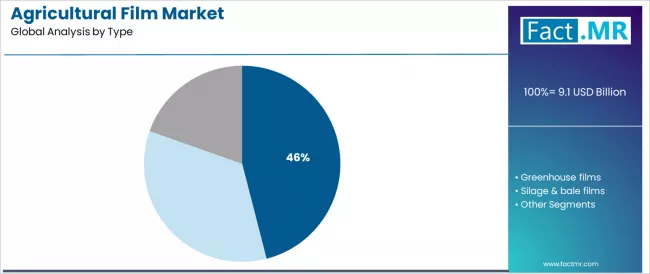
Market Position: Mulch films command the leading position in the market with 46% market share through advanced crop protection features, including superior soil coverage characteristics, moisture retention, and weed control that enable farmers to achieve optimal yields across diverse fruit and vegetable applications.
Value Drivers: The segment benefits from farmer preference for reliable crop protection systems that provide consistent yield performance, reduced herbicide requirements, and soil optimization without requiring significant equipment modifications. Advanced mulch features enable automated laying systems, moisture management, and integration with existing farming equipment, where crop performance and cost effectiveness represent critical agricultural requirements.
Competitive Advantages: Mulch films differentiate through proven crop reliability, consistent soil management characteristics, and integration with precision farming systems that enhance agricultural effectiveness while maintaining optimal cost standards for diverse fruit and vegetable applications.
Key market characteristics:
- Advanced mulch designs with optimized coverage configuration and soil management capabilities
- Enhanced crop effectiveness, enabling 15-25% yield improvement with reliable performance
- Farming compatibility, including automated laying systems, irrigation integration, and process optimization for crop performance
Greenhouse Films Show Strong Controlled Environment Applications
Greenhouse films maintain a 32% market position in the agricultural film market due to their proven climate control and protected cultivation characteristics. These systems appeal to growers requiring controlled environments with competitive positioning for high-value crop and protected cultivation applications. Market growth is driven by controlled agriculture segment expansion, focusing reliable climate solutions and operational efficiency through proven designs.
Silage & Bale Films Serve Feed Preservation Applications
Silage & bale films account for 22% market share, serving feed preservation applications requiring moisture barrier properties and specialized storage characteristics for livestock feed requirements.
By Material, the LDPE/LLDPE Blends Segment Shows Market Leadership
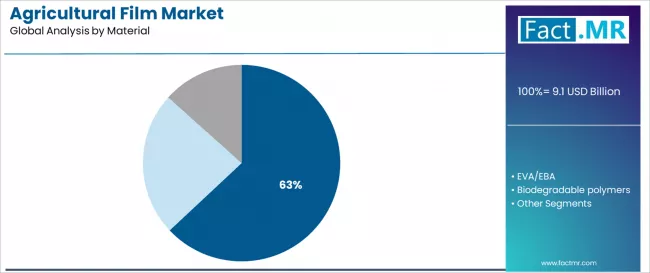
Market Context: LDPE/LLDPE blend materials demonstrate market leadership in the market with 63% share due to widespread adoption of cost-effective film systems and increasing focus on durability optimization, weather resistance, and processing compatibility that maximize agricultural performance while maintaining cost standards.
Appeal Factors: Agricultural manufacturers prioritize material consistency, processing reliability, and integration with existing film production infrastructure that enables coordinated manufacturing operations across multiple product lines. The segment benefits from substantial cost optimization investment and production programs that emphasize the acquisition of reliable polymer systems for film manufacturing and agricultural applications.
Growth Drivers: Agricultural film production incorporates LDPE/LLDPE systems as standard components for manufacturing operations, while cost efficiency trends increase demand for consistent material capabilities that comply with performance standards and minimize production costs.
Application dynamics include:
- Strong growth in cost-effective films requiring reliable material capabilities
- Increasing adoption in durability optimization and weather resistance applications for film manufacturers
- Rising integration with automated production systems for operational optimization and cost assurance
EVA/EBA Applications Maintain Strong Performance Demand
EVA/EBA applications capture 21% market share through comprehensive performance requirements in specialty films, enhanced flexibility applications, and premium agricultural operations. These facilities demand reliable polymer systems capable of operating in demanding environments while providing effective processing integration and performance capabilities.
Biodegradable Polymers Show Environmental Growth
Biodegradable polymers account for 16% market share, including eco-friendly alternatives, compostable films, and environmentally friendly applications requiring efficient polymer solutions for sustainability optimization and environmental compliance.
By End Use, the Fruits & Vegetables Segment Leads Market Share
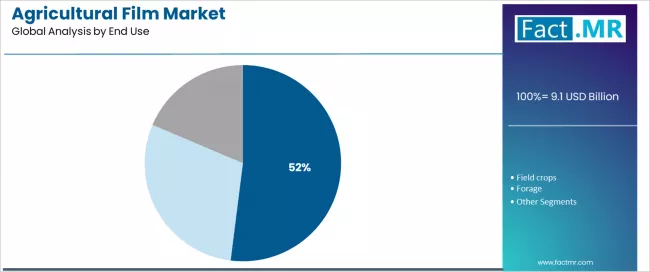
The fruits & vegetables segment commands 52% market share through widespread adoption in high-value crop applications, precision farming operations, and specialty crop production. These systems provide advanced crop protection solutions for complex agricultural requirements while maintaining yield consistency and quality reliability.
Field Crops Systems Show Strong Commodity Demand
Field crops systems capture 30% market share, serving commodity agriculture, large-scale farming, and crop operations requiring cost-effective film capabilities for efficiency optimization and yield enhancement.
Forage Applications Show Specialized Growth
Forage applications account for 18% market share, addressing livestock feed production, silage storage, and feed preservation requiring specialized film solutions for storage optimization.
What are the Drivers, Restraints, and Key Trends of the Agricultural Film Market?
| Category | Factor | Impact | Why It Matters |
|---|---|---|---|
| Driver | Food security & crop yield optimization (population growth, agricultural productivity) | ★★★★★ | Large-scale agricultural production requires efficient crop protection solutions with consistent quality and yield integration across farming applications. |
| Driver | Water conservation & resource management (drought conditions, irrigation efficiency) | ★★★★★ | Drives demand for moisture-retentive film solutions and water-efficient capabilities; suppliers providing conservation features gain competitive advantage. |
| Driver | Precision agriculture & technology adoption (automated farming, data-driven decisions) | ★★★★☆ | Farmers need advanced, technology-compatible film solutions; demand for smart agricultural films expanding addressable market segments. |
| Restraint | Environmental concerns & plastic pollution (eco-friendly regulations, disposal challenges) | ★★★★☆ | Environmentally conscious operations face regulatory pressure; increases disposal complexity and affects adoption in sustainability-focused segments with strict regulations. |
| Restraint | Raw material price volatility & supply chain (petroleum derivatives, cost fluctuations) | ★★★☆☆ | Cost-sensitive farmers face price pressure; complex supply chains limiting adoption in price-sensitive agricultural segments. |
| Trend | Biodegradable films & eco-friendly alternatives (environmental compliance, circular economy) | ★★★★★ | Growing demand for eco-friendly agricultural films; environmental positioning becomes core value proposition in eco-conscious farming segments. |
| Trend | Smart films & precision agriculture integration (sensor integration, data collection) | ★★★★☆ | Technology advancement drives demand for intelligent film solutions; precision capabilities drive differentiation toward data-driven farming applications. |
Analysis of the Agricultural Film Market by Key Country
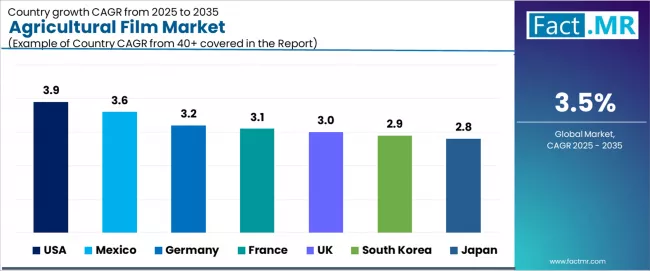
The market demonstrates varied regional dynamics with growth leaders including United States (3.9% growth rate) and Mexico (3.6% growth rate) driving expansion through agricultural modernization initiatives and crop optimization development. Strong Performers encompass Germany (3.2% growth rate), France (3.1% growth rate), and United Kingdom (3.0% growth rate), benefiting from established agricultural industries and advanced farming adoption. Mature Markets feature South Korea (2.9% growth rate) and Japan (2.8% growth rate), where precision farming and agricultural optimization requirements support consistent growth patterns.
Regional synthesis reveals North American markets leading adoption through agricultural modernization expansion and crop technology trends, while European countries maintain steady expansion supported by sustainability requirements and precision farming standards. Emerging markets show strong growth driven by food security applications and agricultural modernization trends.
| Region/Country | 2025-2035 Growth | How to win | What to watch out |
|---|---|---|---|
| United States | 3.9% | Focus on precision agriculture solutions | Environmental regulations; cost pressures |
| Mexico | 3.6% | Value-oriented farming applications | Infrastructure challenges; technical support |
| Germany | 3.2% | Offer eco-friendly agriculture systems | Over-regulation; environmental compliance |
| France | 3.1% | Provide precision farming solutions | Market competition; regulatory complexity |
| United Kingdom | 3.0% | Push advanced agricultural technologies | Post-Brexit regulations; climate challenges |
| South Korea | 2.9% | Lead with high-tech farming applications | Land limitations; technology costs |
| Japan | 2.8% | Premium precision positioning | Market maturity; aging farmers |
United States Drives Fastest Market Growth
The United States establishes fastest market growth through comprehensive agricultural modernization programs and extensive crop optimization development, integrating advanced agricultural film systems as standard components in farming facilities, greenhouse operations, and crop production installations. The country's 3.9% growth rate reflects agricultural initiatives promoting precision farming and yield optimization capabilities that mandate the use of advanced film systems in agricultural projects. Growth concentrates in major agricultural regions, including California, Iowa, and Texas, where farming technology development showcases integrated film systems that appeal to farmers seeking advanced crop protection capabilities and yield optimization applications.
American manufacturers are developing high-performance agricultural film solutions that combine domestic production advantages with advanced crop protection features, including biodegradable systems and enhanced eco-friendly compatibility. Distribution channels through agricultural supply distributors and farming service providers expand market access, while agricultural investment support for precision farming supports adoption across diverse crop segments.
Strategic Market Indicators:
- Agricultural operations leading adoption with 68% deployment rate in farming and greenhouse sectors
- Government agricultural programs providing substantial support for domestic farming technology development
- Local film manufacturers capturing 39% market share through competitive pricing and localized agricultural support
- Export market development for advanced agricultural films targeting international farming markets
Mexico Emerges as High-Growth Market
In Mexico's agricultural regions, including Sinaloa, Sonora, and Jalisco, farming facilities and agricultural operations are implementing advanced film systems as standard components for crop protection and yield enhancement, driven by increasing agricultural investment and farming modernization programs that emphasize the importance of crop management capabilities. The market holds a 3.6% growth rate, supported by government agricultural initiatives and rural development programs that promote advanced film systems for crop applications. Mexican operators are adopting agricultural film systems that provide consistent crop performance and cost-effectiveness features, particularly appealing in farming regions where production efficiency and yield standards represent critical agricultural requirements.
Market expansion benefits from growing agricultural processing capabilities and farming agreements that enable domestic deployment of cost-effective film systems for crop applications. Technology adoption follows patterns established in agricultural equipment, where efficiency and reliability drive procurement decisions and operational deployment.
Germany Shows Eco-friendly Agriculture Leadership
Germany's advanced agricultural technology market demonstrates sophisticated film system deployment with documented operational effectiveness in eco-friendly applications and precision farming projects through integration with existing agricultural systems and farming infrastructure. The country leverages agricultural expertise in sustainable technology and environmental compliance to maintain a 3.2% growth rate. Agricultural centers, including Lower Saxony, Bavaria, and North Rhine-Westphalia, showcase premium installations where film systems integrate with comprehensive sustainability platforms and environmental management systems to optimize farming operations and environmental effectiveness.
German manufacturers prioritize environmental compliance and EU agricultural regulations in product development, creating demand for premium systems with advanced features, including biodegradability integration and automated sustainability systems. The market benefits from established sustainable agriculture infrastructure and willingness to invest in advanced film technologies that provide long-term environmental benefits and compliance with international eco-friendly standards.
France Shows Precision Farming Focus
France establishes precision farming focus through comprehensive agricultural modernization and technology development, integrating film systems across farming facilities and crop operations. The country's 3.1% growth rate reflects mature agricultural relationships and established farming adoption that supports widespread use of film systems in French and European facilities. Growth concentrates in major agricultural regions, including Nouvelle-Aquitaine, Occitanie, and Grand Est, where agricultural technology showcases mature film deployment that appeals to operators seeking proven farming capabilities and precision agriculture applications.
French manufacturers leverage established agricultural networks and comprehensive farming capabilities, including crop management programs and technical support that create farmer relationships and operational advantages. The market benefits from mature agricultural standards and farming requirements that mandate film system use while supporting technology advancement and agricultural optimization.
United Kingdom Shows Advanced Farming Development
The United Kingdom establishes advanced farming development through comprehensive agricultural modernization and technology integration, integrating film systems across farming and greenhouse applications. The country's 3.0% growth rate reflects growing agricultural investment and increasing adoption of film technology that supports expanding use of protection systems in UK farming facilities. Growth concentrates in major agricultural areas, including East of England, South West, and Yorkshire, where farming technology development showcases integrated film systems that appeal to UK farmers seeking advanced protection solutions with crop compatibility.
The UK manufacturers focus on maintaining agricultural standards while adopting advanced farming positioning, creating demand for systems that balance performance with environmental advantages. The market benefits from strong agricultural infrastructure and growing farming opportunities that support film technology adoption while maintaining environmental standards important to UK agricultural applications.
Europe Market Split by Country
The agricultural film market in Europe is projected to grow from USD 2.4 billion in 2025 to USD 3.2 billion by 2035, registering a CAGR of 3.1% over the forecast period. Germany is expected to maintain its leadership position with a 26.4% market share in 2025, declining slightly to 25.9% by 2035, supported by its advanced agricultural infrastructure and major farming regions including Lower Saxony and Bavaria.
France follows with a 22.7% share in 2025, projected to reach 23.1% by 2035, driven by comprehensive precision farming programs and sustainable agriculture strategies. The United Kingdom holds a 20.1% share in 2025, expected to decrease to 19.6% by 2035 due to post-Brexit agricultural adjustments. Italy commands a 17.2% share, while Spain accounts for 12.3% in 2025. The Rest of Europe region is anticipated to gain momentum, expanding its collective share from 1.3% to 1.7% by 2035, attributed to increasing eco-friendly farming adoption in Nordic countries and emerging Eastern European agricultural facilities implementing farming modernization programs.
Japan Demonstrates Agricultural Precision Focus
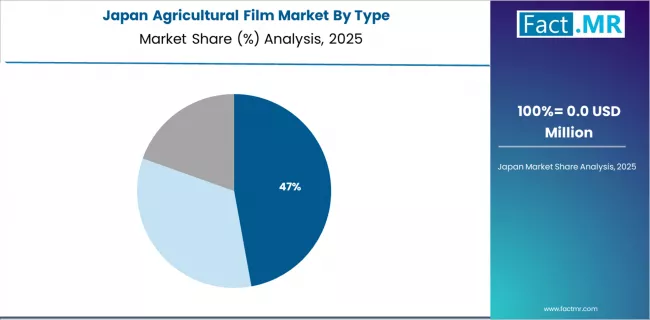
Japan's advanced agricultural technology market demonstrates sophisticated film system deployment with documented operational effectiveness in precision farming applications and controlled environment projects through integration with existing quality systems and agricultural infrastructure. The country maintains a 2.8% growth rate, leveraging traditional agricultural expertise and systematic integration in film technology. Agricultural centers, including Hokkaido, Ibaraki, and Chiba, showcase premium installations where film systems integrate with traditional farming platforms and modern agricultural management systems to optimize crop operations and maintain agricultural quality profiles.
Japanese manufacturers prioritize agricultural precision and quality consistency in film development, creating demand for premium systems with advanced features, including quality monitoring and automated farming systems. The market benefits from established precision infrastructure and commitment to agricultural standards that provide long-term farming benefits and compliance with traditional precision agricultural methods.
South Korea Shows Smart Agriculture Development
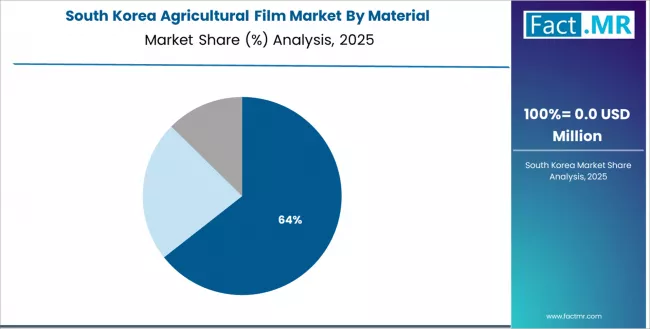
South Korea establishes smart agriculture development through comprehensive farming modernization and technology integration, integrating film systems across technology-focused agriculture and precision applications. The country's 2.9% growth rate reflects growing agricultural investment and increasing adoption of film technology that supports expanding use of smart systems in Korean farming facilities. Growth concentrates in major agricultural areas, including Jeolla, Gyeonggi, and Chungcheong, where agricultural technology development showcases integrated film systems that appeal to Korean farmers seeking advanced protection solutions with technology compatibility.
Korean manufacturers focus on maintaining innovation standards while adopting smart farming efficiency, creating demand for systems that balance performance with technological advantages. The market benefits from strong agricultural technology infrastructure and growing innovation opportunities that support film technology adoption while maintaining quality standards important to Korean agricultural applications.
Competitive Landscape of the Agricultural Film Market
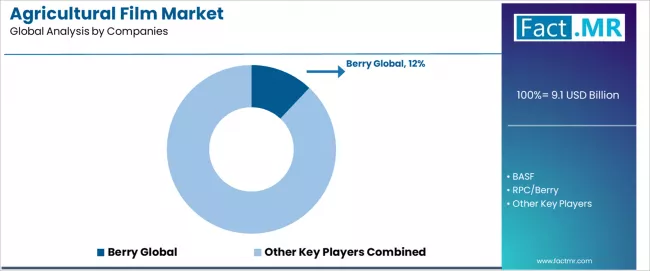
- Structure: ~15-20 credible players; top 5 hold ~40-45% by revenue.
- Leadership is maintained through: material innovation expertise, agricultural application knowledge, and sustainability reliability (crop performance + environmental compliance + farming integration).
- What's commoditizing: standard LDPE mulch films and basic greenhouse coverings.
- Margin Opportunities: biodegradable alternatives, smart agricultural films, and comprehensive farming packages (installation services, crop consulting, sustainability programs).
| Stakeholder | What they actually control | Typical strengths | Typical blind spots |
|---|---|---|---|
| Global polymer platforms | Material scale, R&D capabilities, supply chain reach | Broad product portfolio, proven reliability, cost efficiency | Innovation cycles; agricultural specialization |
| Agricultural film specialists | Crop expertise; farming applications; biodegradable alternatives | Deep agricultural knowledge; farmer relationships; specialized solutions | Scale limitations; material breadth |
| Regional agricultural suppliers | Local farming networks, fast delivery, crop support | "Close to farmer" service; regional crop knowledge; competitive pricing | Technology gaps; eco-friendly capabilities |
| Sustainability focused players | Biodegradable alternatives, circular economy, environmental compliance | Environmental positioning; regulatory advantage; future-proof solutions | Performance trade-offs; cost competitiveness |
| Technology integrators | Smart films, precision agriculture, data analytics | Innovation leadership; technology integration; data capabilities | Agricultural market penetration; farmer adoption |
The competitive landscape demonstrates increasing focus on sustainability and precision agriculture integration, with leading players leveraging comprehensive material portfolios to maintain market position. Innovation centers on biodegradable alternatives and smart farming integration, while regional players compete through agricultural expertise and farmer relationships. Market dynamics favor companies with strong sustainability credentials and agricultural application knowledge, as environmental regulations drive demand for eco-friendly, high-performance film solutions across farming applications.
Key Players in the Agricultural Film Market
- Berry Global
- BASF
- RPC/Berry
- Novamont
- Shell Polymers
- DuPont
- FKuR
- Trioplast
- Solvay
- RKW Group
Scope of the Report
| Items | Values |
|---|---|
| Quantitative Units (2025) | USD 9.1 billion |
| Type | Mulch films, Greenhouse films, Silage & bale films |
| Material | LDPE/LLDPE blends, EVA/EBA, Biodegradable polymers |
| End Use | Fruits & vegetables, Field crops, Forage |
| Regions Covered | Asia Pacific, North America, Europe, Latin America, Middle East & Africa |
| Countries Covered | United States, Germany, Japan, United Kingdom, France, South Korea, Mexico, and 30+ additional countries |
| Key Companies Profiled | Berry Global, BASF, RPC/Berry, Novamont, Shell Polymers, DuPont |
| Additional Attributes | Dollar sales by type and material categories, regional adoption trends across Asia Pacific, North America, and Europe, competitive landscape with film manufacturers and agricultural suppliers, farmer preferences for crop protection consistency and film reliability, integration with precision agriculture platforms and farming systems, innovations in agricultural film technology and sustainability enhancement, and development of advanced biodegradable solutions with enhanced performance and environmental optimization capabilities. |
Agricultural Film Market by Segments
-
Type :
- Mulch films
- Greenhouse films
- Silage & bale films
-
Material :
- LDPE/LLDPE blends
- EVA/EBA
- Biodegradable polymers
-
End Use :
- Fruits & vegetables
- Field crops
- Forage
-
Region :
- Asia Pacific
- China
- Japan
- South Korea
- India
- ASEAN
- Australia & New Zealand
- Rest of Asia Pacific
- North America
- United States
- Canada
- Mexico
- Europe
- Germany
- France
- United Kingdom
- Italy
- Spain
- Rest of Europe
- Latin America
- Brazil
- Rest of Latin America
- Middle East & Africa
- GCC Countries
- South Africa
- Rest of Middle East & Africa
- Asia Pacific
Table of Content
- Executive Summary
- Global Market Outlook
- Demand to side Trends
- Supply to side Trends
- Technology Roadmap Analysis
- Analysis and Recommendations
- Market Overview
- Market Coverage / Taxonomy
- Market Definition / Scope / Limitations
- Market Background
- Market Dynamics
- Drivers
- Restraints
- Opportunity
- Trends
- Scenario Forecast
- Demand in Optimistic Scenario
- Demand in Likely Scenario
- Demand in Conservative Scenario
- Opportunity Map Analysis
- Product Life Cycle Analysis
- Supply Chain Analysis
- Investment Feasibility Matrix
- Value Chain Analysis
- PESTLE and Porter’s Analysis
- Regulatory Landscape
- Regional Parent Market Outlook
- Production and Consumption Statistics
- Import and Export Statistics
- Market Dynamics
- Global Market Analysis 2020 to 2024 and Forecast, 2025 to 2035
- Historical Market Size Value (USD Million) Analysis, 2020 to 2024
- Current and Future Market Size Value (USD Million) Projections, 2025 to 2035
- Y to o to Y Growth Trend Analysis
- Absolute $ Opportunity Analysis
- Global Market Pricing Analysis 2020 to 2024 and Forecast 2025 to 2035
- Global Market Analysis 2020 to 2024 and Forecast 2025 to 2035, By Type
- Introduction / Key Findings
- Historical Market Size Value (USD Million) Analysis By Type , 2020 to 2024
- Current and Future Market Size Value (USD Million) Analysis and Forecast By Type , 2025 to 2035
- Mulch films
- Greenhouse films
- Silage & bale films
- Y to o to Y Growth Trend Analysis By Type , 2020 to 2024
- Absolute $ Opportunity Analysis By Type , 2025 to 2035
- Global Market Analysis 2020 to 2024 and Forecast 2025 to 2035, By Material
- Introduction / Key Findings
- Historical Market Size Value (USD Million) Analysis By Material, 2020 to 2024
- Current and Future Market Size Value (USD Million) Analysis and Forecast By Material, 2025 to 2035
- LDPE/LLDPE blends
- EVA/EBA
- Biodegradable polymers
- Y to o to Y Growth Trend Analysis By Material, 2020 to 2024
- Absolute $ Opportunity Analysis By Material, 2025 to 2035
- Global Market Analysis 2020 to 2024 and Forecast 2025 to 2035, By End Use
- Introduction / Key Findings
- Historical Market Size Value (USD Million) Analysis By End Use, 2020 to 2024
- Current and Future Market Size Value (USD Million) Analysis and Forecast By End Use, 2025 to 2035
- Fruits & vegetables
- Field crops
- Forage
- Y to o to Y Growth Trend Analysis By End Use, 2020 to 2024
- Absolute $ Opportunity Analysis By End Use, 2025 to 2035
- Global Market Analysis 2020 to 2024 and Forecast 2025 to 2035, By Region
- Introduction
- Historical Market Size Value (USD Million) Analysis By Region, 2020 to 2024
- Current Market Size Value (USD Million) Analysis and Forecast By Region, 2025 to 2035
- North America
- Latin America
- Western Europe
- Eastern Europe
- East Asia
- South Asia and Pacific
- Middle East & Africa
- Market Attractiveness Analysis By Region
- North America Market Analysis 2020 to 2024 and Forecast 2025 to 2035, By Country
- Historical Market Size Value (USD Million) Trend Analysis By Market Taxonomy, 2020 to 2024
- Market Size Value (USD Million) Forecast By Market Taxonomy, 2025 to 2035
- By Country
- USA
- Canada
- Mexico
- By Type
- By Material
- By End Use
- By Country
- Market Attractiveness Analysis
- By Country
- By Type
- By Material
- By End Use
- Key Takeaways
- Latin America Market Analysis 2020 to 2024 and Forecast 2025 to 2035, By Country
- Historical Market Size Value (USD Million) Trend Analysis By Market Taxonomy, 2020 to 2024
- Market Size Value (USD Million) Forecast By Market Taxonomy, 2025 to 2035
- By Country
- Brazil
- Chile
- Rest of Latin America
- By Type
- By Material
- By End Use
- By Country
- Market Attractiveness Analysis
- By Country
- By Type
- By Material
- By End Use
- Key Takeaways
- Western Europe Market Analysis 2020 to 2024 and Forecast 2025 to 2035, By Country
- Historical Market Size Value (USD Million) Trend Analysis By Market Taxonomy, 2020 to 2024
- Market Size Value (USD Million) Forecast By Market Taxonomy, 2025 to 2035
- By Country
- Germany
- UK
- Italy
- Spain
- France
- Nordic
- BENELUX
- Rest of Western Europe
- By Type
- By Material
- By End Use
- By Country
- Market Attractiveness Analysis
- By Country
- By Type
- By Material
- By End Use
- Key Takeaways
- Eastern Europe Market Analysis 2020 to 2024 and Forecast 2025 to 2035, By Country
- Historical Market Size Value (USD Million) Trend Analysis By Market Taxonomy, 2020 to 2024
- Market Size Value (USD Million) Forecast By Market Taxonomy, 2025 to 2035
- By Country
- Russia
- Poland
- Hungary
- Balkan & Baltic
- Rest of Eastern Europe
- By Type
- By Material
- By End Use
- By Country
- Market Attractiveness Analysis
- By Country
- By Type
- By Material
- By End Use
- Key Takeaways
- East Asia Market Analysis 2020 to 2024 and Forecast 2025 to 2035, By Country
- Historical Market Size Value (USD Million) Trend Analysis By Market Taxonomy, 2020 to 2024
- Market Size Value (USD Million) Forecast By Market Taxonomy, 2025 to 2035
- By Country
- China
- Japan
- South Korea
- By Type
- By Material
- By End Use
- By Country
- Market Attractiveness Analysis
- By Country
- By Type
- By Material
- By End Use
- Key Takeaways
- South Asia and Pacific Market Analysis 2020 to 2024 and Forecast 2025 to 2035, By Country
- Historical Market Size Value (USD Million) Trend Analysis By Market Taxonomy, 2020 to 2024
- Market Size Value (USD Million) Forecast By Market Taxonomy, 2025 to 2035
- By Country
- India
- ASEAN
- Australia & New Zealand
- Rest of South Asia and Pacific
- By Type
- By Material
- By End Use
- By Country
- Market Attractiveness Analysis
- By Country
- By Type
- By Material
- By End Use
- Key Takeaways
- Middle East & Africa Market Analysis 2020 to 2024 and Forecast 2025 to 2035, By Country
- Historical Market Size Value (USD Million) Trend Analysis By Market Taxonomy, 2020 to 2024
- Market Size Value (USD Million) Forecast By Market Taxonomy, 2025 to 2035
- By Country
- Kingdom of Saudi Arabia
- Other GCC Countries
- Turkiye
- South Africa
- Other African Union
- Rest of Middle East & Africa
- By Type
- By Material
- By End Use
- By Country
- Market Attractiveness Analysis
- By Country
- By Type
- By Material
- By End Use
- Key Takeaways
- Key Countries Market Analysis
- USA
- Pricing Analysis
- Market Share Analysis, 2024
- By Type
- By Material
- By End Use
- Canada
- Pricing Analysis
- Market Share Analysis, 2024
- By Type
- By Material
- By End Use
- Mexico
- Pricing Analysis
- Market Share Analysis, 2024
- By Type
- By Material
- By End Use
- Brazil
- Pricing Analysis
- Market Share Analysis, 2024
- By Type
- By Material
- By End Use
- Chile
- Pricing Analysis
- Market Share Analysis, 2024
- By Type
- By Material
- By End Use
- Germany
- Pricing Analysis
- Market Share Analysis, 2024
- By Type
- By Material
- By End Use
- UK
- Pricing Analysis
- Market Share Analysis, 2024
- By Type
- By Material
- By End Use
- Italy
- Pricing Analysis
- Market Share Analysis, 2024
- By Type
- By Material
- By End Use
- Spain
- Pricing Analysis
- Market Share Analysis, 2024
- By Type
- By Material
- By End Use
- France
- Pricing Analysis
- Market Share Analysis, 2024
- By Type
- By Material
- By End Use
- India
- Pricing Analysis
- Market Share Analysis, 2024
- By Type
- By Material
- By End Use
- ASEAN
- Pricing Analysis
- Market Share Analysis, 2024
- By Type
- By Material
- By End Use
- Australia & New Zealand
- Pricing Analysis
- Market Share Analysis, 2024
- By Type
- By Material
- By End Use
- China
- Pricing Analysis
- Market Share Analysis, 2024
- By Type
- By Material
- By End Use
- Japan
- Pricing Analysis
- Market Share Analysis, 2024
- By Type
- By Material
- By End Use
- South Korea
- Pricing Analysis
- Market Share Analysis, 2024
- By Type
- By Material
- By End Use
- Russia
- Pricing Analysis
- Market Share Analysis, 2024
- By Type
- By Material
- By End Use
- Poland
- Pricing Analysis
- Market Share Analysis, 2024
- By Type
- By Material
- By End Use
- Hungary
- Pricing Analysis
- Market Share Analysis, 2024
- By Type
- By Material
- By End Use
- Kingdom of Saudi Arabia
- Pricing Analysis
- Market Share Analysis, 2024
- By Type
- By Material
- By End Use
- Turkiye
- Pricing Analysis
- Market Share Analysis, 2024
- By Type
- By Material
- By End Use
- South Africa
- Pricing Analysis
- Market Share Analysis, 2024
- By Type
- By Material
- By End Use
- USA
- Market Structure Analysis
- Competition Dashboard
- Competition Benchmarking
- Market Share Analysis of Top Players
- By Regional
- By Type
- By Material
- By End Use
- Competition Analysis
- Competition Deep Dive
- Berry Global
- Overview
- Product Portfolio
- Profitability by Market Segments (Product/Age /Sales Channel/Region)
- Sales Footprint
- Strategy Overview
- Marketing Strategy
- Product Strategy
- Channel Strategy
- BASF
- RPC/Berry
- Novamont
- Shell Polymers
- DuPont
- FKuR
- Trioplast
- Solvay
- RKW Group
- Berry Global
- Competition Deep Dive
- Assumptions & Acronyms Used
- Research Methodology
List Of Table
- Table 1: Global Market Value (USD Million) Forecast by Region, 2020 to 2035
- Table 2: Global Market Value (USD Million) Forecast by Type , 2020 to 2035
- Table 3: Global Market Value (USD Million) Forecast by Material, 2020 to 2035
- Table 4: Global Market Value (USD Million) Forecast by End Use, 2020 to 2035
- Table 5: North America Market Value (USD Million) Forecast by Country, 2020 to 2035
- Table 6: North America Market Value (USD Million) Forecast by Type , 2020 to 2035
- Table 7: North America Market Value (USD Million) Forecast by Material, 2020 to 2035
- Table 8: North America Market Value (USD Million) Forecast by End Use, 2020 to 2035
- Table 9: Latin America Market Value (USD Million) Forecast by Country, 2020 to 2035
- Table 10: Latin America Market Value (USD Million) Forecast by Type , 2020 to 2035
- Table 11: Latin America Market Value (USD Million) Forecast by Material, 2020 to 2035
- Table 12: Latin America Market Value (USD Million) Forecast by End Use, 2020 to 2035
- Table 13: Western Europe Market Value (USD Million) Forecast by Country, 2020 to 2035
- Table 14: Western Europe Market Value (USD Million) Forecast by Type , 2020 to 2035
- Table 15: Western Europe Market Value (USD Million) Forecast by Material, 2020 to 2035
- Table 16: Western Europe Market Value (USD Million) Forecast by End Use, 2020 to 2035
- Table 17: Eastern Europe Market Value (USD Million) Forecast by Country, 2020 to 2035
- Table 18: Eastern Europe Market Value (USD Million) Forecast by Type , 2020 to 2035
- Table 19: Eastern Europe Market Value (USD Million) Forecast by Material, 2020 to 2035
- Table 20: Eastern Europe Market Value (USD Million) Forecast by End Use, 2020 to 2035
- Table 21: East Asia Market Value (USD Million) Forecast by Country, 2020 to 2035
- Table 22: East Asia Market Value (USD Million) Forecast by Type , 2020 to 2035
- Table 23: East Asia Market Value (USD Million) Forecast by Material, 2020 to 2035
- Table 24: East Asia Market Value (USD Million) Forecast by End Use, 2020 to 2035
- Table 25: South Asia and Pacific Market Value (USD Million) Forecast by Country, 2020 to 2035
- Table 26: South Asia and Pacific Market Value (USD Million) Forecast by Type , 2020 to 2035
- Table 27: South Asia and Pacific Market Value (USD Million) Forecast by Material, 2020 to 2035
- Table 28: South Asia and Pacific Market Value (USD Million) Forecast by End Use, 2020 to 2035
- Table 29: Middle East & Africa Market Value (USD Million) Forecast by Country, 2020 to 2035
- Table 30: Middle East & Africa Market Value (USD Million) Forecast by Type , 2020 to 2035
- Table 31: Middle East & Africa Market Value (USD Million) Forecast by Material, 2020 to 2035
- Table 32: Middle East & Africa Market Value (USD Million) Forecast by End Use, 2020 to 2035
List Of Figures
- Figure 1: Global Market Pricing Analysis
- Figure 2: Global Market Value (USD Million) Forecast 2020-2035
- Figure 3: Global Market Value Share and BPS Analysis by Type , 2025 and 2035
- Figure 4: Global Market Y to o to Y Growth Comparison by Type , 2025-2035
- Figure 5: Global Market Attractiveness Analysis by Type
- Figure 6: Global Market Value Share and BPS Analysis by Material, 2025 and 2035
- Figure 7: Global Market Y to o to Y Growth Comparison by Material, 2025-2035
- Figure 8: Global Market Attractiveness Analysis by Material
- Figure 9: Global Market Value Share and BPS Analysis by End Use, 2025 and 2035
- Figure 10: Global Market Y to o to Y Growth Comparison by End Use, 2025-2035
- Figure 11: Global Market Attractiveness Analysis by End Use
- Figure 12: Global Market Value (USD Million) Share and BPS Analysis by Region, 2025 and 2035
- Figure 13: Global Market Y to o to Y Growth Comparison by Region, 2025-2035
- Figure 14: Global Market Attractiveness Analysis by Region
- Figure 15: North America Market Incremental Dollar Opportunity, 2025-2035
- Figure 16: Latin America Market Incremental Dollar Opportunity, 2025-2035
- Figure 17: Western Europe Market Incremental Dollar Opportunity, 2025-2035
- Figure 18: Eastern Europe Market Incremental Dollar Opportunity, 2025-2035
- Figure 19: East Asia Market Incremental Dollar Opportunity, 2025-2035
- Figure 20: South Asia and Pacific Market Incremental Dollar Opportunity, 2025-2035
- Figure 21: Middle East & Africa Market Incremental Dollar Opportunity, 2025-2035
- Figure 22: North America Market Value Share and BPS Analysis by Country, 2025 and 2035
- Figure 23: North America Market Value Share and BPS Analysis by Type , 2025 and 2035
- Figure 24: North America Market Y to o to Y Growth Comparison by Type , 2025-2035
- Figure 25: North America Market Attractiveness Analysis by Type
- Figure 26: North America Market Value Share and BPS Analysis by Material, 2025 and 2035
- Figure 27: North America Market Y to o to Y Growth Comparison by Material, 2025-2035
- Figure 28: North America Market Attractiveness Analysis by Material
- Figure 29: North America Market Value Share and BPS Analysis by End Use, 2025 and 2035
- Figure 30: North America Market Y to o to Y Growth Comparison by End Use, 2025-2035
- Figure 31: North America Market Attractiveness Analysis by End Use
- Figure 32: Latin America Market Value Share and BPS Analysis by Country, 2025 and 2035
- Figure 33: Latin America Market Value Share and BPS Analysis by Type , 2025 and 2035
- Figure 34: Latin America Market Y to o to Y Growth Comparison by Type , 2025-2035
- Figure 35: Latin America Market Attractiveness Analysis by Type
- Figure 36: Latin America Market Value Share and BPS Analysis by Material, 2025 and 2035
- Figure 37: Latin America Market Y to o to Y Growth Comparison by Material, 2025-2035
- Figure 38: Latin America Market Attractiveness Analysis by Material
- Figure 39: Latin America Market Value Share and BPS Analysis by End Use, 2025 and 2035
- Figure 40: Latin America Market Y to o to Y Growth Comparison by End Use, 2025-2035
- Figure 41: Latin America Market Attractiveness Analysis by End Use
- Figure 42: Western Europe Market Value Share and BPS Analysis by Country, 2025 and 2035
- Figure 43: Western Europe Market Value Share and BPS Analysis by Type , 2025 and 2035
- Figure 44: Western Europe Market Y to o to Y Growth Comparison by Type , 2025-2035
- Figure 45: Western Europe Market Attractiveness Analysis by Type
- Figure 46: Western Europe Market Value Share and BPS Analysis by Material, 2025 and 2035
- Figure 47: Western Europe Market Y to o to Y Growth Comparison by Material, 2025-2035
- Figure 48: Western Europe Market Attractiveness Analysis by Material
- Figure 49: Western Europe Market Value Share and BPS Analysis by End Use, 2025 and 2035
- Figure 50: Western Europe Market Y to o to Y Growth Comparison by End Use, 2025-2035
- Figure 51: Western Europe Market Attractiveness Analysis by End Use
- Figure 52: Eastern Europe Market Value Share and BPS Analysis by Country, 2025 and 2035
- Figure 53: Eastern Europe Market Value Share and BPS Analysis by Type , 2025 and 2035
- Figure 54: Eastern Europe Market Y to o to Y Growth Comparison by Type , 2025-2035
- Figure 55: Eastern Europe Market Attractiveness Analysis by Type
- Figure 56: Eastern Europe Market Value Share and BPS Analysis by Material, 2025 and 2035
- Figure 57: Eastern Europe Market Y to o to Y Growth Comparison by Material, 2025-2035
- Figure 58: Eastern Europe Market Attractiveness Analysis by Material
- Figure 59: Eastern Europe Market Value Share and BPS Analysis by End Use, 2025 and 2035
- Figure 60: Eastern Europe Market Y to o to Y Growth Comparison by End Use, 2025-2035
- Figure 61: Eastern Europe Market Attractiveness Analysis by End Use
- Figure 62: East Asia Market Value Share and BPS Analysis by Country, 2025 and 2035
- Figure 63: East Asia Market Value Share and BPS Analysis by Type , 2025 and 2035
- Figure 64: East Asia Market Y to o to Y Growth Comparison by Type , 2025-2035
- Figure 65: East Asia Market Attractiveness Analysis by Type
- Figure 66: East Asia Market Value Share and BPS Analysis by Material, 2025 and 2035
- Figure 67: East Asia Market Y to o to Y Growth Comparison by Material, 2025-2035
- Figure 68: East Asia Market Attractiveness Analysis by Material
- Figure 69: East Asia Market Value Share and BPS Analysis by End Use, 2025 and 2035
- Figure 70: East Asia Market Y to o to Y Growth Comparison by End Use, 2025-2035
- Figure 71: East Asia Market Attractiveness Analysis by End Use
- Figure 72: South Asia and Pacific Market Value Share and BPS Analysis by Country, 2025 and 2035
- Figure 73: South Asia and Pacific Market Value Share and BPS Analysis by Type , 2025 and 2035
- Figure 74: South Asia and Pacific Market Y to o to Y Growth Comparison by Type , 2025-2035
- Figure 75: South Asia and Pacific Market Attractiveness Analysis by Type
- Figure 76: South Asia and Pacific Market Value Share and BPS Analysis by Material, 2025 and 2035
- Figure 77: South Asia and Pacific Market Y to o to Y Growth Comparison by Material, 2025-2035
- Figure 78: South Asia and Pacific Market Attractiveness Analysis by Material
- Figure 79: South Asia and Pacific Market Value Share and BPS Analysis by End Use, 2025 and 2035
- Figure 80: South Asia and Pacific Market Y to o to Y Growth Comparison by End Use, 2025-2035
- Figure 81: South Asia and Pacific Market Attractiveness Analysis by End Use
- Figure 82: Middle East & Africa Market Value Share and BPS Analysis by Country, 2025 and 2035
- Figure 83: Middle East & Africa Market Value Share and BPS Analysis by Type , 2025 and 2035
- Figure 84: Middle East & Africa Market Y to o to Y Growth Comparison by Type , 2025-2035
- Figure 85: Middle East & Africa Market Attractiveness Analysis by Type
- Figure 86: Middle East & Africa Market Value Share and BPS Analysis by Material, 2025 and 2035
- Figure 87: Middle East & Africa Market Y to o to Y Growth Comparison by Material, 2025-2035
- Figure 88: Middle East & Africa Market Attractiveness Analysis by Material
- Figure 89: Middle East & Africa Market Value Share and BPS Analysis by End Use, 2025 and 2035
- Figure 90: Middle East & Africa Market Y to o to Y Growth Comparison by End Use, 2025-2035
- Figure 91: Middle East & Africa Market Attractiveness Analysis by End Use
- Figure 92: Global Market - Tier Structure Analysis
- Figure 93: Global Market - Company Share Analysis
- FAQs -
How big is the agricultural film market in 2025?
The global agricultural film market is estimated to be valued at USD 9.1 billion in 2025.
What will be the size of agricultural film market in 2035?
The market size for the agricultural film market is projected to reach USD 12.8 billion by 2035.
How much will be the agricultural film market growth between 2025 and 2035?
The agricultural film market is expected to grow at a 3.5% CAGR between 2025 and 2035.
What are the key product types in the agricultural film market?
The key product types in agricultural film market are mulch films, greenhouse films and silage & bale films.
Which material segment to contribute significant share in the agricultural film market in 2025?
In terms of material, ldpe/lldpe blends segment to command 63.0% share in the agricultural film market in 2025.